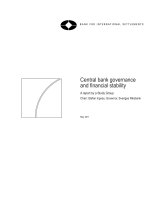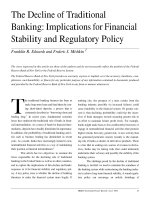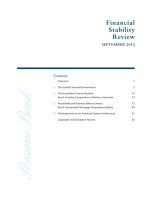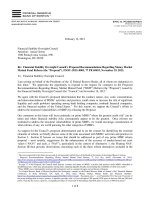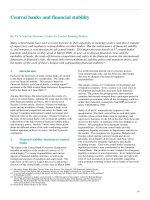Potential financial stability issues arising from recent trends in Exchange-Traded Funds (ETFs) ppt
Bạn đang xem bản rút gọn của tài liệu. Xem và tải ngay bản đầy đủ của tài liệu tại đây (151.63 KB, 7 trang )
Potential financial stability issues arising from recent trends in
Exchange-Traded Funds (ETFs)
12 April 2011
i
Table of Contents
Introduction 1
1. ETFs: a fast-growing market, underpinned by strong innovation 1
2. Potential financial stability risks in some corners of the ETF market 3
Increase in complexity and opacity; Synthetic ETFs 3
Risks for market liquidity; Incentives for securities lending 4
3. Risk implications for authorities, ETF investors and providers 5
1
Potential financial stability issues arising from recent trends in
Exchange-Traded Funds (ETFs)
Introduction
As part of its mandate, the Financial Stability Board (FSB) monitors market developments
and advises on their implications for regulatory policy
1
. In doing so, it seeks to identify
potential vulnerabilities and the actions that may be needed to address them. The recent rapid
growth and innovation in the market for Exchange Traded Funds (ETFs) is a development
that the FSB believes warrants increased attention by regulatory and supervisory authorities,
as well as by the ETF industry, including providers, market-makers and investors. This note
highlights a number of recent developments that call for such attention.
ETFs were created in the early nineties, initially as a plain-vanilla equity product, and provide
investors with the flexibility and cost-efficiency of exchange-traded products, together with
the diversification benefits of mutual funds. Although most of the ETF market remains plain-
vanilla, there has been an increase in product variety and, in some cases, complexity, albeit
with some differences across regions and markets.
While the growth in ETF markets is at an early stage in a number of countries, the speed and
breadth of financial innovation in the ETF market has been remarkable in some large financial
systems over the past five years, and has brought new elements of complexity and opacity
into this standardised market. There are a number of disquieting developments in some
market segments which call for closer scrutiny. ETFs have branched out to other asset classes
(fixed-income, credit, emerging markets, commodities) where liquidity is typically thinner
and transparency lower. The increased popularity of “synthetic” ETFs (which use derivatives)
as well as the more intensive recourse to securities lending by ETF providers of plain-vanilla
ETFs raises new challenges in terms of counterparty and collateral risks. In addition, the
expectation of on-demand liquidity may create the conditions for acute redemption pressures
on certain types of ETFs in situations of market stress, which could in turn affect the liquidity
of the large asset managers and banks active in this market.
Therefore, the drivers and implications of the recent wave of financial innovation in ETF
markets warrants closer surveillance of potential vulnerabilities by financial stability
authorities to ensure that the market grows in a sustainable and safe way.
1. ETFs: a fast-growing market, underpinned by strong innovation
ETFs are investment vehicles that track an index (e.g. S&P 500), trade continuously on
exchanges—in contrast with traditional mutual funds which are valued only once a day—and
are redeemable daily. Thus, their main advantage is to combine the low-cost diversification
benefits of index-linked and basket products with the high liquidity and tradability of
individual stocks. In normal times, plain-vanilla ETFs can also offer an additional source of
liquidity for the underlying markets in which they trade.
1
FSB Charter, available on
2
At the end of Q3 2010, the global ETF industry had $1.2 trillion in assets under management,
85% in plain-vanilla ETFs referenced to equity indices (Graph 1), which is equivalent to 5%
of global mutual fund assets and 2% of global equity market capitalisation. The industry has
grown at an average of 40% a year over the past 10 years, which dwarfs the growth rate of
both global mutual funds and equity markets (around 5% a year). Most ETFs are listed on US
and European exchanges, but they provide exposure to a much more diverse range of markets
(e.g., two of the three largest ETFs worldwide track emerging market indices).
Over time, the ETF market has grown in size, complexity and diversity (Graph 1 shows the
dynamics and relative importance of different asset classes and characteristics). There are
broadly speaking two main structures for ETFs. Physical ETFs are “plain-vanilla” products
that replicate the index by simply reconstituting the basket of physical securities underlying
the index (e.g. the basket of S&P 500 stocks) with appropriate weights
2
. They are the
dominant form of ETF¸ especially in the US and are mainly provided by large independent
asset managers. Synthetic ETFs obtain the desired return through entering into an asset swap,
i.e. an OTC derivative, with a counterparty, instead of replicating the index physically (see
section 2). They have developed very rapidly in Europe to reach 45% of that market (Graph
1), and are also growing in some Asian markets. They are typically provided by asset
management arms of banks. One factor supporting their growth resides in the synergies
created within banking groups if the derivative trading desk acts as swap counterparty to the
asset management arm providing the ETF. Another factor is the more liberal stance of
European regulation on the use of derivatives in investment funds, while the US regulator has
adopted a more conservative approach, limiting de facto the development of synthetic ETFs
3
.
While institutional investors are dominant in European ETFs, the investor base for US ETFs
is evenly balanced between retail and institutional investors.
Graph 1
The ETF market: main characteristics and recent trends
Global ETF market by asset type
1
Synthetic and physical ETFs in Europe
1
0
250
500
750
1,000
1,250
1,500
2005 2006 2007 2008 2009 2010
Equity
Fixed income
Commodity
0
50
100
150
200
250
300
2005 2006 2007 2008 2009 2010
Physical
Synthetic
1
Assets Under Management, in billions of US dollars.
Sources: Blackrock; Bloomberg.
2
To limit transaction costs due to the rebalancing of index components, physical ETFs generally hold a sample of the
securities composing the index rather than the full basket. The resulting basis risks related to the physical ETFs’ index
tracking quality are generally managed from the revenues that the ETF derives from securities lending.
3
In Europe, ETFs are covered under UCITS III regulation which allows the use of derivatives within certain limits not only
for hedging purposes but for investment purposes as well. In the US, the SEC announced
in March 2010 that it is conducting
a review to evaluate the use of derivatives by ETFs, and has therefore deferred consideration of new and pending requests for
authorisation of ETFs that would make significant investments in derivatives.
3
2. Potential financial stability risks in some corners of the ETF market
While ETFs bring a number of benefits to investors and market participants, including cost
efficiency, diversification and easier access to specific asset classes or risk exposures, they
may also generate new types of risks, linked to the complexity and relative opacity of the
newest breed of ETFs. The impact of such innovations on market liquidity and on financial
institutions servicing the management of the fund is not yet fully understood by market
participants, especially during episodes of acute market stress.
Increase in complexity and opacity; Synthetic ETFs
Product innovation has recently flourished in the ETF market, , as well as in the market for
close substitutes of ETFs such as ETNs or ETVs, which are essentially debt products (while
ETFs are funds
4
), extending the asset class beyond its initial plain-vanilla standardised nature.
Some new products are archetypes of this trend (leveraged ETFs, inverse ETFs, and
leveraged-inverse ETFs
5
), although as yet they represent only a tiny fraction of the market,
around 3% of total. The first ETF of speculative grade corporate loans was also recently
launched. The complexity and opacity characterising these innovations warrants closer
surveillance as it may leave investors exposed to risks they have not anticipated.
Among recent innovations, a specific trend warranting closer scrutiny is the recent
acceleration in the growth of synthetic ETFs on some European and Asian markets. In this
type of ETF, the provider (typically a bank’s asset management arm) sells ETF shares to
investors in exchange for cash, which is then invested in a collateral basket, the return of
which is swapped by the derivatives desk of the same bank for the return of an index (e.g.
S&P 500, see Diagram 1).
Diagram 1
Simplified functioning of a synthetic ETF on the S&P 500
S&P 500 ETF
ETF provider
Collateral
basket
Swap
counterparty
Cash
Share
Cash Collateral
basket
return
Collateral
basket
return
S&P 500
return
Investor
Share
Cash
o
f
t
e
n
t
h
e
s
a
m
e
b
a
n
ki
n
g
g
r
o
u
p
S&P 500 ETF
ETF provider
Collateral
basket
Swap
counterparty
Cash
Share
Cash Collateral
basket
return
Collateral
basket
return
S&P 500
return
Investor
Share
Cash
S&P 500 ETF
ETF provider
Collateral
basket
Swap
counterparty
Cash
Share
Cash Collateral
basket
return
Collateral
basket
return
S&P 500
return
Investor
Share
Cash
o
f
t
e
n
t
h
e
s
a
m
e
b
a
n
ki
n
g
g
r
o
u
p
4
Exchange-traded notes (ETNs) are listed debt products issued by financial institutions. ETNs may be very similar to ETFs
in a number of respects, but are not subject to fund requirements such as diversification rules. Exchange-traded vehicles
(ETVs) are debt securities similar to ETNs but issued by SPVs, and thus entailing more counterparty risk. ETFs, ETNs and
ETVs are generally designated as exchange-traded products (ETPs).
5
Leveraged ETFs aim to deliver a magnified performance of a particular index, while inverse (or short) ETFs track the
opposite performance of an index. Leveraged-inverse ETFs are a combination of both. The most popular leveraged ETFs
provide exposures of +/- 2x or 3x the daily returns of an index.
4
Since the swap counterparty is typically the bank also acting as ETF provider, investors may
be exposed if the bank defaults
6
. Therefore, problems at those banks that are most active in
swap-based ETFs may constitute a powerful source of contagion and systemic risk.
In addition, the incentives behind the creation of synthetic ETFs may not be aligned along the
ETF chain, especially as conflicts of interest can arise from the dual role of some banks as
ETF provider and derivative counterparty
7
. As there is no requirement for the collateral
composition to match the assets of the tracked index
8
, the synthetic ETF creation process may
be driven by the possibility for the bank to raise funding against an illiquid portfolio that
cannot otherwise be financed in the repo market. For instance, in diagram 1, the collateral
basket for a S&P 500 synthetic ETF could be less liquid equities or low or unrated corporate
bonds in an unrelated market. In case of unexpected liquidity demand from ETF investors, the
provider might face difficulties liquidating the collateral and may be faced with the difficult
choice of either suspending redemptions or maintaining them and facing a liquidity shortfall
at the bank level. In short, risks increase if the bank considers the synthetic ETF structure as a
stable and inexpensive source of funding for illiquid securities. ETF investors may not always
have sufficient control over collateral arrangements to enable them to prevent such a situation.
More broadly, investors in synthetic ETFs need to exercise an adequate level of scrutiny and
due diligence on collateral selection and arrangements, which in turn depends on the level of
transparency made available by ETF providers. Important considerations relate to the rules for
selecting the collateral, the screening of its credit quality and its liquidity, valuation practices
and haircut determination, and segregation of assets. The existence of regulatory or other
limits regarding the derivative exposure would also help contain the risks mentioned above.
Risks for market liquidity; Incentives for securities lending
While benefiting formally from market making arrangements, ETFs may nevertheless
experience liquidity disruptions. In principle, ETFs offer on-demand liquidity to investors
while they are in some cases based on much less liquid underlying assets. Therefore, in the
event of a market sell-off or an unwind in any particular ETF, there is a risk that investors
massively demand redemption. Depending on the specific ETF arrangements, redemptions
could be made “in-kind” which would alleviate liquidity pressures. However, were
redemptions to be made in cash, this could raise issues as to the exit strategies and liquidity
risk of ETF providers and swap counterparties. Further study would also be useful for
assessing the potential impact of heavy ETF trading on the liquidity and the price dynamics of
the referenced securities, particularly if they do not have an active secondary market (e.g.
emerging market ETFs).
In the same vein, thin margins on plain-vanilla physical ETFs create incentives for providers
to engage in extensive securities lending in order to boost returns. Some ETF providers are
said to generate more fee income from securities lending than from their traditional
6
Some ETFs give investors the option of selecting a group of banks as swap counterparties instead of a single institution, but
given the high level of interconnectedness among major banks, investors would remain exposed to episodes of generalised
increase in counterparty risk.
7
Other types of conflicts of interest can arise in non-synthetic ETFs as well, for instance if the ETF provider is also involved
in the design and/or calculation of the reference index, or also acts as liquidity provider on the secondary market of the ETF.
8
Under European UCITS III regulation, the collateral may be selected among OECD equities or bonds.
5
management fees. Since securities lending is a bilateral collateralised operation, it may create
similar counterparty and collateral risks to synthetic ETFs. In addition, it could make the
liquidity position of the ETF fragile, by challenging the ability of ETF providers to meet
unexpected liquidity demands from investors, particularly if outflows from ETFs become
significant under severe stress. A prevalence of securities lending could create a risk of a
market squeeze in the underlying securities if ETF providers recalled on-loan securities on a
large scale in order to meet redemptions. In addition, the use of ETFs as collateral in a long
chain of secured lending and rehypothecation may create operational risks and contribute to
the build up of leverage. In this regard, it is worth noting that some jurisdictions impose
reporting and disclosure requirements (e.g. on-exchange registration) on securities lending
that would contribute to lower risks.
3. Risk implications for authorities, ETF investors and providers
The very strong growth of collateralised structured operations in the context of synthetic ETFs
and ETF-based securities lending suggests that there are significant benefits for authorities
and ETF market participants alike in improving their understanding of the risks attached, and
the ways in which they can be mitigated. The current protracted period of low interest rates
provides incentives for re-leveraging in non-standard market segments, which may lead to a
build up of financial vulnerabilities, especially as the process of financial repair is not
complete. Potential destabilising interactions with other financial innovations (e.g., high-
frequency trading
9
) that could amplify negative effects also require attention.
Market and banking supervisors and regulators are in the process of stepping up their
monitoring of the ETF market. Work is underway nationally and internationally on assessing
how recent innovations in this area can add to financial system risks, what incentives underpin
them, and what potential flaws there might be in current risk practices. The interaction of ETF
regulatory frameworks with recent innovations as well as the scope for regulatory arbitrage
across regions and markets is also being examined. Imposing higher disclosure and reporting
requirements as well as regulatory and other limits could help to alleviate the risks emerging
in complex instruments, and prevent the emergence of conflicts of interest.
In view of the new challenges raised by recent trends on ETF markets, ETF providers and
investors should review the risk management strategies of ETFs, especially in areas such as
counterparty risk and collateral management, as well as assessing their exposure to market
and funding liquidity risks. Furthermore, ETF providers should consider enhancing the level
of transparency they offer to investors on the entire range of ETF products, especially the
more complex ones. In particular, they should make publicly available detailed frequent
information about product composition and risk characteristics, including on collateral baskets
and arrangements for synthetic ETFs and securities lending, to enable investors to exercise
their due diligence and promote a better understanding of the ETF market at large.
9
See report of the staffs of the CFTC and SEC on “Findings regarding the market events of May 6, 2010”.


